Beautiful, smaller versions of the famous racing dogs, Italian Greyhounds come in many colors. Shades, combinations, and patterns create distinctive good looks in these refined pooches. But not all shades are available everywhere in the world. The primary differences are found between American and European options. But let’s take a look at the Italian greyhound colors in all regions for the fullest possible picture.
Comprehensive Chart of Italian Greyhound Colors
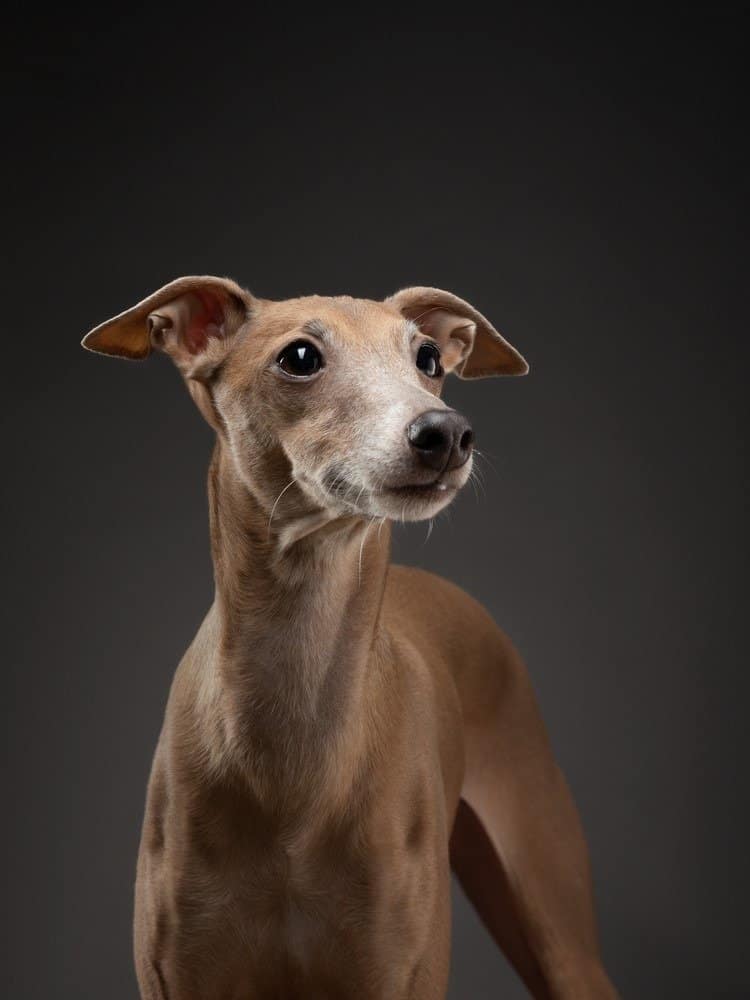
Italian greyhounds come in many colors, some officially accepted, and some not. For officially approved colors for breeding or competing, the AKC offers a full list.
©dezy/Shutterstock.com
Affectionately dubbed “Iggies,” these beautiful Italian greyhounds come in many shades, patterns, and combinations. The official list from the AKC breed site includes:
- Fawn
- Blue
- Red
- Red fawn
- Black
- Blue fawn
- Sable
- Seal
- White and black
- White and blue
- White and fawn
- White and red
- White and red fawn
- White and blue fawn
- White and seal
- White and sable
- Black and tan
- White
- Brindle
- Blue and tan
- Chocolate
- Cream
Non-official colors also include:
- Silver
- Gray
- Tan
- Brown
- Charcoal to soot-black
- Dark red
- Dark gray
What Determines an Italian Greyhound’s Color?
Several factors play into the coloration of an Italian greyhound. Typically, though, coloring is passed from the parents’ genetics to their offspring. If both parents are the same color, for example, puppies are likely to be the same color. But, if your dog’s parents are purebred, the puppies may well come out in different colors. The exact lineage for dogs, apart from purebreds, are difficult to trace, which means a recessive gene may pop out, producing different color variations than expected.
American vs European Italian Greyhound Colors
Iggy colors vary from continent to continent, with the most notable differences found between America and Europe. Europe leans more into solid color Italian greyhounds, while the United States may have any of the colors, including the multi-colored dogs.
What is the Rarest Color of the Italian Greyhound?
A few rare colors and patterns may be found in Italian Greyhounds, primarily in the United States.
Cream
Cream-colored dogs are among the rarest colors of Italian greyhounds. From a distance, the dogs look almost white, while up close, tones of the creamy fawn come into play making up the rare shade. They typically have a black nose and those famous big eyes.
Black
Jet black Italian greyhounds will also prove difficult to find. Some may come in charcoal gray or sooty shades of black, but actual, true black is pretty rare. These coats include no light tones mingled in with the black.
Chocolate
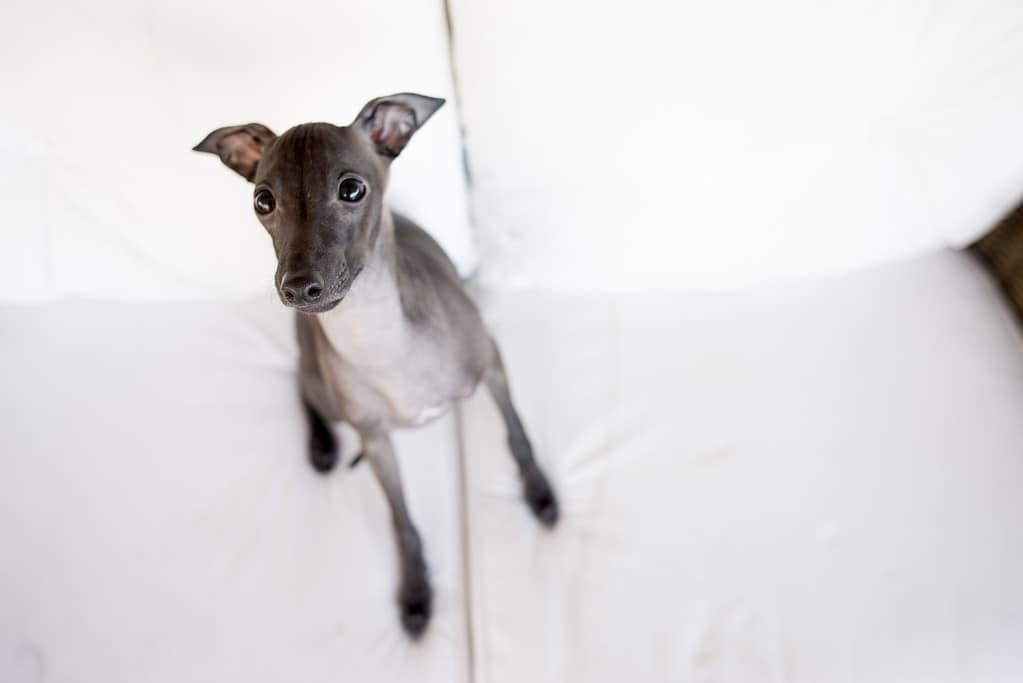
Italian greyhounds that come in chocolate coloring are difficult to find, particularly solid chocolate without white markings.
©claudiio Doenitz/ via Getty Images
These small dogs in chocolate also prove themselves difficult to locate. The rich, dark brown coloring with lighter tones behind the ears and on the legs prove rare.
Mask
Not a true color, but a rare color-form, mask proves challenging to locate in Italian greyhounds. This color variation gives the appearance of darker features around muzzle, ears, and eyes, with the main coat coming in lighter tones. Often, Isabella coats with fawn coloring and black accents create the mask color-form.
The Most Common Italian Greyhound Colors
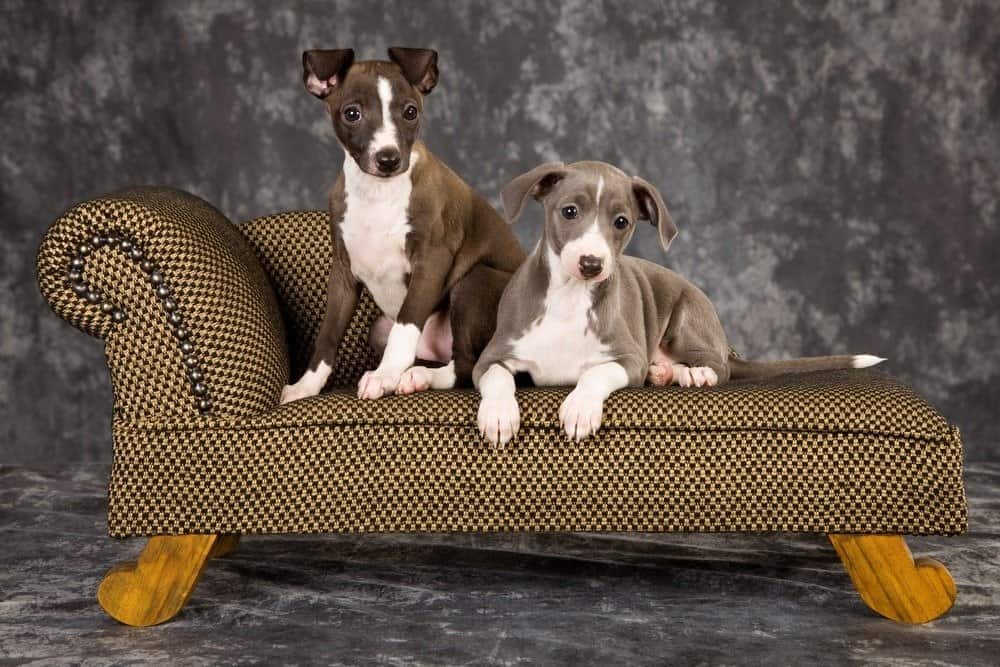
Italian greyhounds commonly come in sable, seal, fawn, tan, brindle, gray, or combinations with white.
©Linn Currie/Shutterstock.com
While it may be difficult to find an Italian greyhound in the rare cream, jet black, chocolate, or mask coloration, there are many beautiful colors much more easily obtained. American greyhounds typically come in more color options, while Europeans are more likely to be solid colors only. These difference result from the lack of interbreeding of European and American dogs.
The most common color variations overall include:
- Sable
- Seal
- Fawn
- Silver
- Tan
- Brindle
- Gray
- Brown
- White and blue
- Charcoal to soot black
- Red fawn
- Blue fawn
- Dark red
- Dark gray
Common European Iggy Colors
In the case of European Italian greyhounds, you are more likely to see solid colors, not mixed colorats and patterns. Occasionally, they have white chests, though this is rare.
Gray

The most popular color found in European Italian greyhounds is gray. Gray shades of many variations, from light to dark, may well be considered a diluted color because of weaker gene pools. The coloring often makes the dogs look blue, though, in the case of paler pigmentation.
Fawn or Isabella
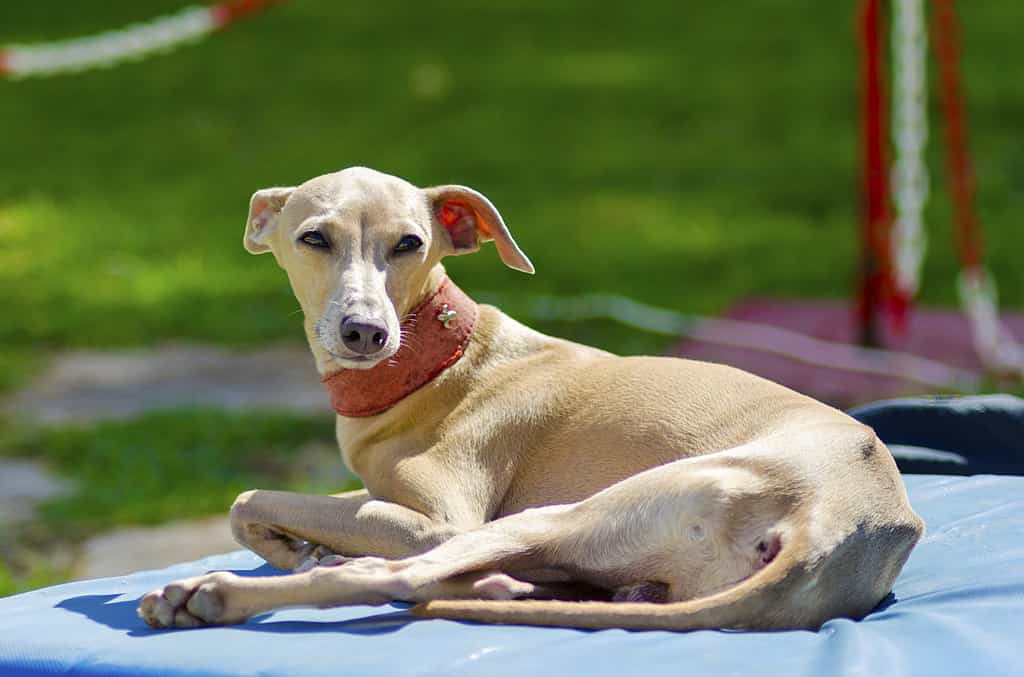
Fawn, usually in solid, is among the most common Italian greyhound colors.
©f8grapher/ via Getty Images
The fawn or Isabella coat ranges from a pale creamy color to dark, rich red shades. When you look closely at the fur, though, you’ll see multiple colors mingling together to create these beautiful shades. Most commonly, fawn coats come in tan and light brown colors.
Common American Iggy Colors
American Italian greyhounds come in a number of other common coloration and patterns. These dogs have just about every imaginable coloration, in fact.
Irish Pattern

Italian greyhounds with white around their heads and necks have “Irish” patterns.
©violet-blue/ via Getty Images
The Irish pattern in Italian greyhounds means any color with a white collar around the neck. This then stretches down to the tops of their feet and chest. They likely have a white muzzle and strip between the eyes, as well.
Prominent white patches in these areas mean the pattern is known as a “wild Irish.”
Pied Pattern
One of the most common Italian greyhound patterns is known as pied. That is, the coat has patches of colors together, much like a piebald pony. The colors are usually dark tan or gray with a white base. The patches don’t follow a particular pattern however, darker sections often cover the head. This often results in a full mask.
Ticking Pattern
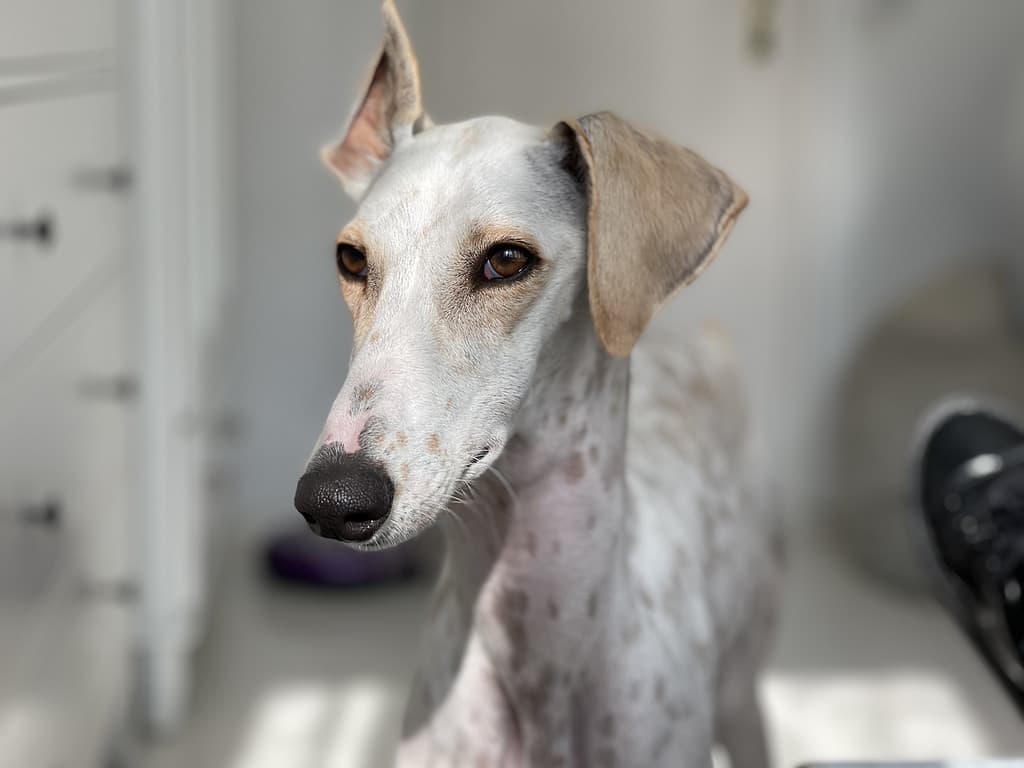
Ticking on an Italian greyhound simply means dots or splashes of color on a white base.
©Dienes Vivien/ via Getty Images
Though it won’t be seen in puppies, ticking is small dots or splashes of other colors atop a white base. Usually, the splotches are on the chest or belly, a bit like those seen in dalmatians. The pattern appears as the dog matures.
Solid Head Pattern
In some cases, an Italian greyhound may have a solid-colored head with a body in a separate color. Usually, the body is solid white, with the head in fawn or gray shades.
Split-face Pattern
A split-face pattern is exactly what it sounds like. An Italian greyhound will have one half of its head in white, with the other half in fawn or gray.
Italian Greyhound Color Changing Coats
A few factors may also result in the Italian greyhound’s coloring to change over time. Sometimes, it appears that the color changes or fades over time. This is fairly normal.
Delayed Diluted Color
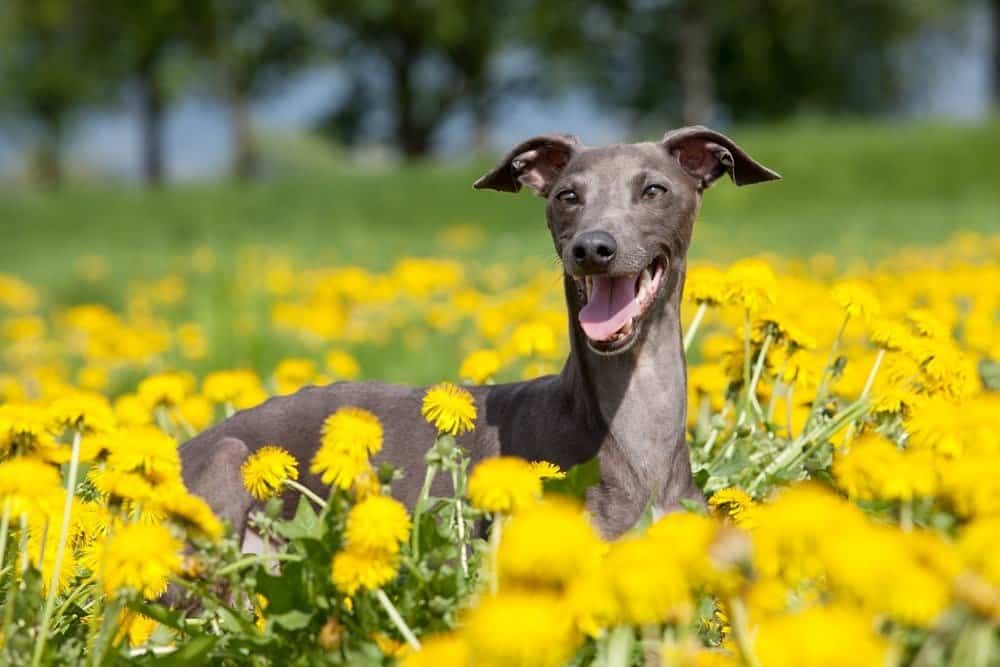
Italian greyhounds may “fade” over time due to aging.
©Lenkadan/Shutterstock.com
The most common cause for a coat color change is something known as delayed diluted color. Iggy puppies often have dark fur that fades as the dig matures. This occurs because of a specific gene carried by some dogs. Dogs with Isabella coats in dark reds are the most prone to this happening.
Seasonal Shifts
Sometimes, your Iggy might darken in winter and go lighter in summer. This simply happens because of sun bleaching. This is perfectly normal and nothing to worry about.
Maturation
Just like humans go gray as they age, dogs can, too. Often, Italian greyhounds develop gray patches as they get older. It’s nothing to feel concerned about.
Facial Staining
The final normal reason Italian greyhounds may change colors somewhat is something called facial staining. Saliva and tears both contain components that may literally stain the dog’s face if it has a light coat. This is another completely natural thing and shouldn’t be worries about.
Color Dilution Alopecia (CDA)
While it isn’t as low-key as facial staining or seasonal shifts, color dilution Alopecia also may change a dog’s coloration. This occurs specifically in dogs with a specific gene mutation. More common in European Italian greyhounds, the condition affects coloration and may result in hair loss.
Alopecia begins at the shoulders, with hair loss, and runs down the spine to the tail. Eventually, a dog with this genetic marker may become completely bald.
How to Identify Color Dilution Alopecia in Greyhounds
When you bathe your Italian greyhound, you may notice lots of fur washing away. You could also notice your dog’s skin becomes patchy or scaly. These are likely signs that your pooch has this condition.
How to Treat Color Dilution Alopecia
At this time, no known cure for color dilution Alopecia exists. The genetic passage of the gene goes down the line of dogs, generation after generation. If you’re concerned about having a dog with such a condition, be sure to check the dog’s family history for others with the condition.
Fortunately, though it gives these pooches to cuddle up, Alopecia does not affect internal health. Italian greyhounds with Alopecia can be perfectly healthy.
The photo featured at the top of this post is © Dienes Vivien/ via Getty Images
Ready to discover the top 10 cutest dog breeds in the entire world?
How about the fastest dogs, the largest dogs and those that are -- quite frankly -- just the kindest dogs on the planet? Each day, AZ Animals sends out lists just like this to our thousands of email subscribers. And the best part? It's FREE. Join today by entering your email below.
Thank you for reading! Have some feedback for us? Contact the AZ Animals editorial team.







